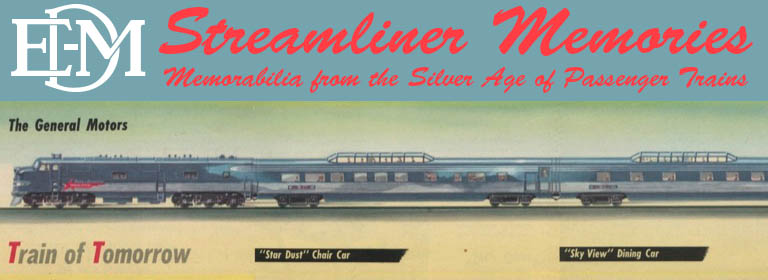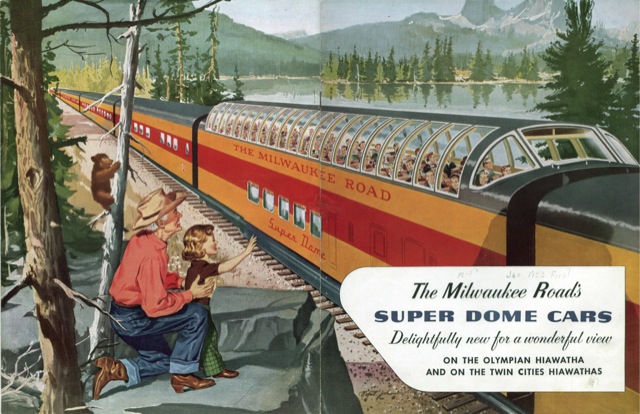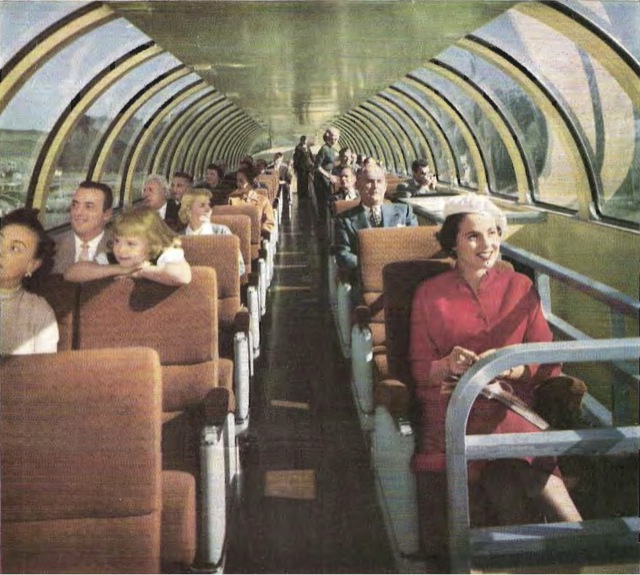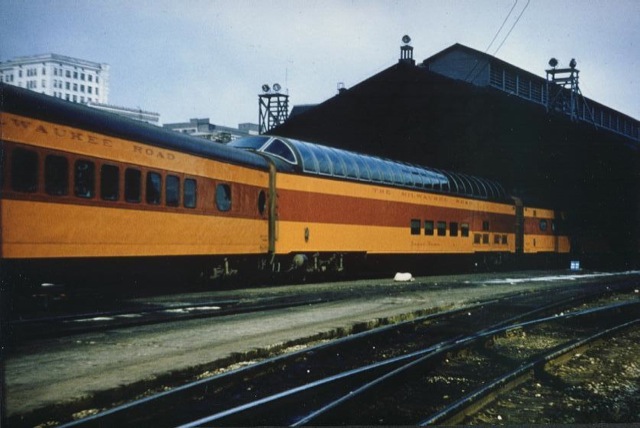After the Super Chief received its domes on January 29, 1951, no further trains became domeliners until 1952, when domes were added to several minor trains: the Missouri Pacific Texas Eagle and Missouri River Eagle in July; the Wabash City of Kansas City in August; and–using cars rotated off the California Zephyr–the Burlington’s Ak-Sar-Ben Zephyr in December. The next (literally) big news for dome cars came on January 1, 1953, when the Milwaukee Road added the first full-length domes to its Hiawatha trains.
The Milwaukee publicity department liked this illustration so well that it also used it on the company’s 1952 annual report. Click image to download a 13.3-MB PDF of a 12-page brochure about the Super Domes.
According to the August, 1952 issue of The Milwaukee Road Magazine, the railroad held a contest to name the cars, and a Milwaukee Road employee named B. H. Perlick won by suggesting “Super Domes.” The term was certainly appropriate. At 200,000 pounds, the cars were far heavier than the typical 120,000 to 140,000 pound weight of a typical streamlined passenger car. Each car’s wheel sets alone weighed more than 65,000 pounds and were the first six-wheel trucks for a streamlined car. Though three inches shorter than the tallest short-domes that had been built up to that time, the extra three inches in the latter domes was for an air conditioning duct in the ceiling, so Super Dome passengers enjoyed front and back windows that were just as large on those of the tallest Budd-built short domes.
Like an ordinary coach, normal seating in the dome was four across, but there were four rows of three-across seating at either end to make room for passengers walking beneath the dome. Click image for a larger view; click here to download a PDF of an article from the December 8, 1952 Railway Age, made available by a Milwaukee Road archive web site.
Despite the height, some dome aficionados complain that full-length domes don’t offer as nice a view as short domes because the dome is too long for passengers to have a 360-degree view. Offsetting that, were the huge panes of glass in the domes–five feet tall and three feet wide–and sightseers benefited from the lack of horizontal posts that divided glass into two rows in the short domes that had been built up to that time. Built by Pullman, they would be the only domes Pullman ever built with curved glass until 1958, when the company made six domes for the City of St. Louis.
The domes required massive air conditioners capable of freezing 20 tons of ice per day (compared to around 8 tons for an ordinary streamlined car) and a 70-horsepower Diesel engine to keep the air conditioners running. The noise and exhaust from this engine probably irked passengers walking outside the car, but the interiors were well insulated.
The 68 seats in the dome portion of the cars was nearly triple the number of seats in a short dome. Unlike short-dome seats, these seats reclined a bit. The final “super” thing about the cars was the cost: at $320,000 (about $2.7 million in today’s money), each Super Dome was more than twice the price of an ordinary streamlined car.
A Super Dome at the Milwaukee, Wisconsin depot. Behind the blank area on the right in the passage through the car. The grills on the right are for the air conditioners. Click image for a larger view.
The domes actually had three levels. At either end of the car, passengers would enter at the level of the adjacent passenger car. From there they had a choice of going up a narrow stairway to the dome or turning right to take a passageway that led through the car. To allow adequate head room in these passageways, there were no seats in the dome above the passages. After passing over the car’s wheel sets, passengers would step down three stairs, allowing them to pass under the dome and optionally enter a sunken lounge with 28 seats supported by a small bar and kitchen.
The Milwaukee Road ordered ten domes from Pullman: six for the Olympian Hiawathas and four for the morning and afternoon Twin Cities Hiawathas. The cars, the company was careful to explain, were an addition to, not a replacement for, the Sky Top observation cars that made the Hiawathas so distinctive. The cars were numbered 50 through 59.
As it turned out, Pullman had to build eleven cars for the order. On an early test run, Super Dome number 50 was destroyed in a wreck and fire. Pullman apparently regarded the replacement car, also numbered 50, as the same car, but in fact only a few parts from the original car were salvageable.



